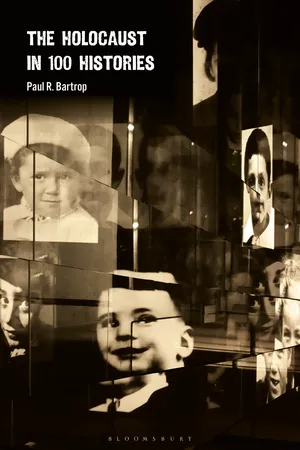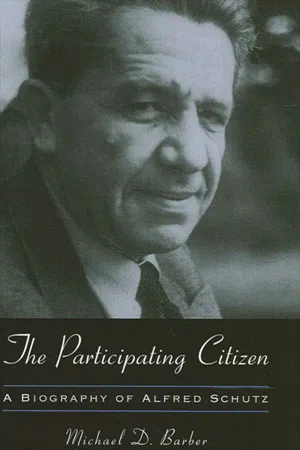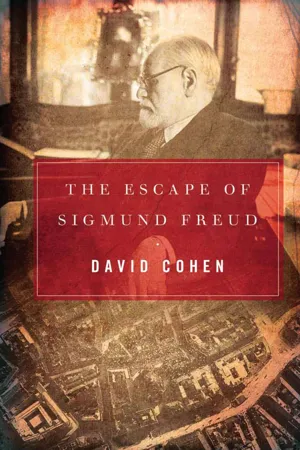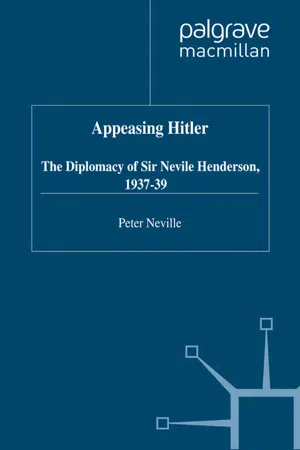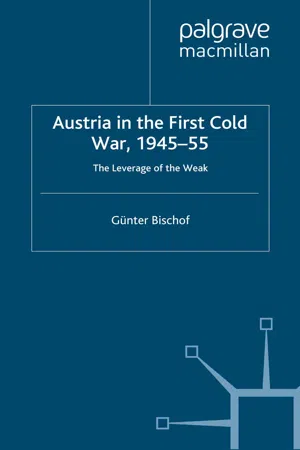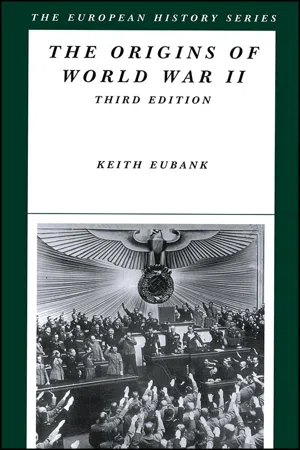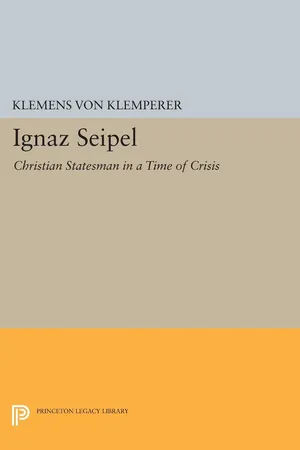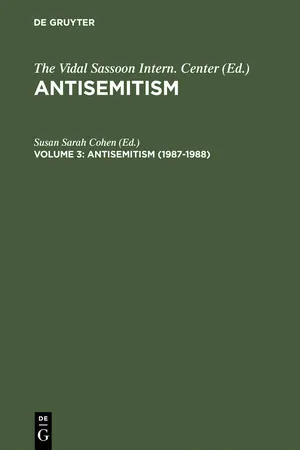History
Anschluss
Anschluss refers to the annexation of Austria into Nazi Germany in 1938. This event violated the Treaty of Versailles and was a significant step in Adolf Hitler's expansionist policies. The Anschluss was met with little resistance from the international community, setting the stage for further aggression by Nazi Germany leading up to World War II.
Written by Perlego with AI-assistance
Related key terms
1 of 5
12 Key excerpts on "Anschluss"
- eBook - ePub
Resistance Heroines in Nazi & Russian Occupied Austria
Anschluss & After
- Tim Heath, Virginia Wells, Herti Bryan(Authors)
- 2022(Publication Date)
- Pen & Sword History(Publisher)
Chapter 3Anschluss
O n 12 March 1938, German troops marched into Austria in what was to become known as the Anschluss (annexation of Austria). There was no gunfire, no blood-curdling scream of Stukas overhead nor the rumble of tanks and artillery. The Anschluss was no Blitzkrieg : on the contrary many Austrians from all backgrounds welcomed the Germans and the union of Austria and Germany which followed. Many Austrian citizens felt that this union was a logical progression in bringing ethnic Germans outside of Nazi Germany into the fold of a Greater Germany. Nazi Germany had provided assistance to the Austrian National Socialist Party (Austrian Nazi Party) in its bid to seize power from the Austrian Fatherland Front government, as outlined in the previous chapter. In a conversation with Nazi propaganda minister, Joseph Goebbels, in the late summer of 1937, Adolf Hitler confided that eventually Austria would have to be taken ‘by force’.On 5 November 1937, Hitler convened a conference with the Foreign Minister Konstantin von Neurath, the War Minister Field Marshal Werner von Blomberg, Army commander General Werner von Fritsch, Kriegsmarine commander Admiral Erich Raeder and Luftwaffe commander Hermann Göring. At this conference Hitler stated that economic problems were causing Germany to fall behind in the arms race with Britain and France and that the only solution was to launch, in the near future, a series of wars to seize Austria and Czechoslovakia, whose resources could be utilized to benefit Germany in the arms race. In early 1938, Hitler was seriously considering replacing Papen as ambassador to Austria with either Colonel Hermann Kriebel, the German consul in Shanghai, or Albert Forster, the Gauleiter of Danzig. Ironically, neither Kriebel nor Forster were professional diplomats. Kriebel had been one of the leaders of the failed 1923 Munich Beer Hall Putsch. He had been appointed consul in Shanghai to facilitate his work in arms procurement and dealing in China. Forster on the other hand was a Gauleiter who had proven he could get along with the Poles within his position in the Free City of Danzig. Both men were committed Nazis who had displayed some diplomatic qualities. On 25 January 1938, the Austrian police raided the Vienna headquarters of the Austrian Nazi Party, arresting Gauleiter Leopold Tavs, the deputy to Captain Josef Leopold, discovering a cache of weapons and plans for a putsch. - eBook - PDF
- Paul R. Bartrop(Author)
- 2024(Publication Date)
- Bloomsbury Academic(Publisher)
55 Part 6 1938 MARCH 1938 6.1 The Anschluss and the Jews of Austria A Jewish presence is believed to have existed in and around Austria from as early as the Roman Empire. The fate of the Jews there waxed and waned over the centuries, but in March 1938, with the invasion of Austria by Nazi Germany, that presence came to a shuddering halt. At the time, Austria had a Jewish population of some 192,000, representing almost 4 percent of the country’s total population. The overwhelming majority of Austrian Jews lived in Vienna, where they comprised about 9 percent of the population. The term given to the Nazi takeover of Austria, Anschluss, is usually understood to mean “linkage,” “connection,” or “union.” Historically, it has come to refer specifically to the annexation of the country by Germany on March 12, 1938. After a prolonged period of authoritarian rule, economic difficulties, and intense localized Nazi propaganda, that morning the German Wehrmacht’s Eighth Army crossed the border. The troops were not met with any significant military or official resistance but were, instead, greeted enthusiastically by cheering Austrians with Nazi salutes, flags, and flowers. Austria was incorporated into the German Reich the next day. Shortly thereafter, the Nazi racial laws were instituted against Austria’s Jewish population, with some 76,000 (mostly men) arrested in the days following their implementation. Many Jews were sent to the concentration camp at Dachau, which had been established, almost to the day, five years earlier. The full force of what the Nazis had been evolving against the Jews in Germany over that period was now brought to bear against Austria’s Jews within a matter of weeks. For example, universities, from which Jews were now banned, lost over 40 percent of their students and professors in a matter of hours, while Jews had their property confiscated and their homes looted or expropriated. - eBook - PDF
The Participating Citizen
A Biography of Alfred Schutz
- Michael D. Barber(Author)
- 2012(Publication Date)
- SUNY Press(Publisher)
73 Chapter 5 Anschluss The Anschluss, the conjoining of Austria and the Third Reich, was, as men- tioned, formally promulgated on March 13, 1938. Under the pretext that Artur Seyss-Inquart, a Nazi who had been appointed minister of the Interior and Security as a result of Hitler’s Berchtesgaden meeting with Schuschnigg, had sent a telegram requesting the aid of German troops to restore law and order in Austria, Hitler’s troops seized Austria. Hermann Göring informed Sir Neville Hendersen that Hitler, entering with his troops and traveling to Linz and later Vienna, was merely visiting the grave of his mother in Austria. As mentioned previously, Hitler was warmly welcomed by large crowds and by officials such as Cardinal Innitzer, the Catholic primate, who met with him in his hotel suite even before he arrived in Vienna and promised that Austria’s Catholics would become “the truest sons of the great Reich into whose arms they had been brought back on this momentous day.” After the 99 percent plebiscite vote in favor of the Anschluss, which even Karl Renner, the former first chancellor of the “German-Austrian Republic” of 1918 had endorsed, the persecution of the Jews described earlier began in earnest. 1 The Emigration of the Immediate Family, March 13, 1938–June 12, 1938 The impact of the Anschluss upon Alfred Schutz and his family was cata- strophic, as Ilse recounted. Five years after the birth of Evelyn Elizabeth Schutz, born May 22, 1933, George, their son, had been born on February 23, 1938. After Alfred had ascertained that his wife and newborn son were of sound health, he had left on a business trip to Paris for two weeks. During his stay in Paris, with his family still in Vienna, Hitler invaded Austria. Since the Nazis would have suspected Alfred as an international banker and busi- nessman of moving monies out of Austria, it was perilous for him to return to Austria, but he was tormented by the thought that the family he loved - eBook - ePub
- David Cohen(Author)
- 2019(Publication Date)
- Abrams Press(Publisher)
9World History in a Teacup: The AnschlussIn Mein Kampf , Hitler wrote: “Reunion [of Austria to Germany, the Anschluss] must be regarded as the supreme task of our lives, and one to be achieved by any means possible. People of one blood should belong to one Reich.” Hitler’s dream was more personal; he longed to return in triumph to the country he had left as a total failure.On November 17, 1937, a group of Austrian politicians visited Hermann Goering. He asked Count Peter Reverta, the director of security along the Upper Austrian Border, “Do you really think that, if the Fuhrer wanted to force the Anschluss, Austria would be able to defend herself?” Austria was not making any defensive preparations, Reverta started to say, but Goering interrupted, “I may as well tell you that this union will be carried out no matter what happens, for the Fuhrer is determined at all costs to settle the question.”Goering specialized in bombast, but there were no specific plans to invade. Hitler wrote a document in June 1937. This file, called Operation Otto because of Otto von Habsburg, assumed that the emperor would be delighted to be set back on his throne by Nazi forces. But Otto resisted the temptation. So Hitler had to improvise and create some pretext for an invasion. It did not have to be too convincing, since Britain and France did not want a new war.By November 1937, Nazi leaders were hinting at the exact time when they would order troops across the border, knowing that neither Britain nor France would lift a finger to stop them. Stanley Baldwin, the British prime minister, had said he “knew little of Europe and disliked what he knew.” His successor, Neville Chamberlain, felt he had a special mission “to come to friendly terms with the dictators of Italy and Germany.”On December 20, 1937, Freud wrote to Stefan Zweig: “The government here is different but the people are the same as their brethren in the Reich. Our throat is being squeezed ever more tightly although for the time being we are not choked completely.” Some Nazi “rules” amazed Freud, particularly the one that banned German Jews giving their children German names. In return, Freud suggested, Jews should ban Germans from using Jewish names like Joseph. “One cannot avoid occasionally thinking of Meister Anton’s closing words in one of Friedrich Hebbel’s dramas: ‘I no longer understand this world.’” - eBook - PDF
Appeasing Hitler
The Diplomacy of Sir Nevile Henderson, 1937-39
- P. Neville(Author)
- 1999(Publication Date)
- Palgrave Macmillan(Publisher)
3 The Anschluss In the early months of 1938 Henderson's attentions were to be focused on two major issues: the possible restoration of German colonies which had been confiscated at Versailles, and the status of the Austrian Republic. As events turned out, the second issue was to overshadow the first as independent Austria, a fragile creation of the 1919 Treaty of Saint Germain, disappeared from the map of Europe as an independent state in March 1938. Ever since Hitler came to power in January 1933 his intentions towards his homeland were plain for all to see, in that he wanted a closer relationship between Austria and the Reich. In July 1934 Hitler was implicated in the failed Austrian Nazi coup which resulted in the assassination of Chancellor Dollfuss. This also brought about the threat of Italian intervention which forced Hitler to hand over the assassins of Dollfuss, who had fled to Germany after the murder. But neither the illusion of unity between Britain, France and Italy nor the ban on Austro-German unity enshrined in Article 80 of the Versailles Treaty could prevent growing pressure on the regime of the new Austrian Chancellor, Kurt von Schuschnigg. This culminated in the so-called Austro-German 'Gentleman's Agreement' in 1936 which brought two crypto-Nazis, Glaise-Horstenau and Guido Schmidt, into the Schuschnigg Government. The agreement also forced Austria to recognise herself to be a German state, and allowed Nazi German newspapers to circulate in Austria again. The Gentleman's Agreement was also clearly a consequence of the great-power realignment which followed Mussolini's attack on Abyssinia in the autumn of 1935. The Austrian Government could no longer rely on Italy for protection. German pressure on Austria reached its extreme point with Hitler's bullying interview with Schuschnigg on 12 February. - eBook - ePub
The Roots of Appeasement
The British Weekly Press and Nazi Germany During the 1930s
- Benny Morris(Author)
- 2022(Publication Date)
- Routledge(Publisher)
Austria, stated Truth, had been ‘artificially separated from Germany’; ‘the status quo is far from satisfactory and peace depends upon its rectification.’ 24 The left-wing and Liberal weeklies were unanimous in their verdict on the Anschluss : it was an unjustifiable act of naked aggression. The Economist, the New Statesman, Time & Tide and Tribune saw it as but a prelude to further aggression by Germany in eastern Europe. The Spectator demurred, venturing that perhaps Hitler would be satisfied with the incorporation of his native land. In any case, argued Wilson Harris, Hider’s intentions towards Czechoslovakia were certainly ‘of a different order from his designs on Austria’. 25 As a result of the Anschluss, the New Statesman called for British participation in a ‘grand alliance’. The Economist and Tribune reiterated their previous call to the same effect The Economist, alone of the Liberal and left-wing weeklies, was moved by the Anschluss to press for greater British rearmament. In retrospect the strangest thing about the weeklies’ reaction to the Anschluss was the speed with which Austria and its population were written off and forgotten. Only Tribune made a point of urging British non-recognition of Austria’s annexation by Germany. It was as if men, despite their professions, had for years resigned themselves to the elimination of Austria; a similar reaction, if even more muted, was to characterise the Italian conquest of Albania a year later. Following Abyssinia, States, apparently, had become as perishable and disposable as consumer goods. The weeklies immediately deemed the annexation irreversible; the possibility of achieving a German withdrawal, through diplomatic pressure or military threat, was not even mooted. Political discussion in the wake of the Anschluss immediately focused on Czechoslovakia; ‘What next’ rather than ‘What of Austria?’ typified the approach. And much of it was of the order of ‘one down and one to go’ - eBook - PDF
Austria in the First Cold War, 1945-55
The Leverage of the Weak
- G. Bischof(Author)
- 1999(Publication Date)
- Palgrave Macmillan(Publisher)
1 The Austrians' Role and Allied Planning during the Second World War Wir waren muttersee/enallein 11 The annexation of Austria by Nazi Germany in 1938 came about as the result of a complex mix of domestic and international factors and was a decisive event on Europe's path to war. Austria's role during the Second World War was highly ambiguous. A majority of Austrians welcomed the German invasion and numer- ous perpetrators from the Ostmark participated eagerly in Hitler's war of exter- mination. A minority of Austrians were shocked about the demise of their country and resisted the Hitler regime. The Austrian economy and society were modernized and rationalized due to the German presence during the war. The Allies' plans for postwar Austria emerged slowly during the course of the war. The British were leading the planning effort and initiated the Moscow Declaration which promised to re-establish an independent Austria. They decided early on not to demand reparations from postwar Austria. The Soviets were deter- mined to make the Austrians pay for their participation in Hitler's barbaric war but never intended to include postwar Austria in their Eastern European sphere of security. In order to understand the Cold War Soviet economic depredations in Austria, Austria's wartime status and the role of Austrians in Nazi Germany needs to be understood. Most of the great-power postwar disagreements over the country were rooted in wartime actions. NO INDIGESTION: THE Anschluss In March 1938 Austrians, like the Gadarene swine, rushed across the precipice to their own doom. Rarely in the annals of mankind has a country so eagerly collab- orated in its own demise. German Austrians - those left over after all other subject peoples had abandoned the ship of the collapsing Habsburg Monarchy - proclaimed their republic in November 1918. A majority of reluctant citizens in the new republic felt that it was a non-viable state. - eBook - PDF
- Keith Eubank(Author)
- 2014(Publication Date)
- Wiley-Blackwell(Publisher)
But this was not the case with Aust ria. Moreover, because the invasion of Austr ia meant going to the brink of war, Hitle r had wavered, but his judgment of how Europe would react proved to be sound . The nat i ons of Europe were just as re lieved as Hitler when , on 1938/95 March 13, in compliance with Hitler's decision, the puppet government in Austria adopted a law declaring the country to be a province of the German Reich . Hitler's victory was sealed with a plebiscite on April 10, when over 99 percent of the Aus-trian voters approved the question Do you acknowledge Adolf Hitler as our Fuehrer and the reunion of Austria with the Ger-man Reich which was affected on March 11, 1938? Many voted ja out of sheer relief that the uncertainty over Austria's future had ended. The Anschluss was the greatest triumph that Hitler had ex-perienced . Those in Germany who had doubted him had been proven wrong. The western powers had taken no action; they were unwilling to intervene. Hitler now felt that he could do whatever he wished to do. No one could oppose him either at home or abroad. No one could stand in his way. He had ignored anyone who advised moderation in his foreign policy. Now that he had brought Austria in the Greater Germany , his next target was Czechoslovakia whose defenses had been weakened by the Anschlus. However, this victory marked a change in Hitler's tactics. Mter this he would cease to concern himself simply with ending restrictions imposed on Germany by the Treaty of Versailles, and he would threaten independent nations with invasion, or even war, unless they capitulated to his demands. The results of his victory were impressive: without a shot being fired, without losing a soldier, and with only a few Austrian units mobilized, Germany had acquired 6 1 /2 million new citizens who would provide ad-ditionallabor and men for eight new army divisions. - eBook - PDF
Ignaz Seipel
Christian Statesman in a Time of Crisis
- Klemens Von Klemperer(Author)
- 2015(Publication Date)
- Princeton University Press(Publisher)
Something of this sort happened to the Texas Republic"; New York Times, October 2, 1928. 305 A Diplomacy for Central Europe able to grant satisfactory guarantees to the European minorities, including of course the Austrian minorities under foreign rule, was he prepared to scrap the premises of Nation una Staat and fall back on the unitary state as a political objective. The Anschluss, in short, was in Seipel's political strategy a "last resort." 32 32 The connection between the failure of other alternatives and the Anschluss had been frequently stated by Seipel, most explicitly in his al- ready quoted Viennese address of 1926, "Das wahre Antlitz Osterreichs": For us Germans the nation . . . , the great cultural community, is higher than the state. . . . Specifically this difference in our assessment of the conception of nation and state . . . gives us the opportunity to find our own way in the so much discussed question of the Anschluss of Austria to Germany. If we do not consider our life fulfilled in the creation of the unitary state, then we can somehow reconcile ourselves with living in a German state which is not part of the German Reich. That there is an advantage to having such a German state we recog- nize, especially in these times when we must witness that the other Germans, who belong to the Reich as little as we but live under other sovereignties, do not have the same national liberties as we do. If, however, only the Western concepts of nation and state are to pre- vail, then the German nation cannot help but aim at the German unitary state, the German national state. (Gessl, Reden, p. 295.) Cf. also the memorandum sent out by the Secretary General of the BaIl- hausplatz Franz Peter to all Austrian chiefs of mission concerning the Chan- cellor's view on the Anschluss question at the time of the Schubert Festival (July 19-22, 1928), which turned out to be an impressive Anschluss dem- onstration. - eBook - PDF
- Herbert A. Strauss(Author)
- 2011(Publication Date)
- De Gruyter(Publisher)
13 Without intending to claim a teleological progress in a straight line in the 'extirpation' of Jews from Viennese society, I shall nevertheless show that the persecution of the Jews in Vienna from 1938 to 1942 moved forward in phases, with each of the various manifestations of antisemitism in Austria being built on the preceding one or at least complementary to it. One can distinguish eight distinctive stages in the progressive elimination of the Jews from Viennese society between 1938 and 1943; these eight stages were required for the progress of the Holocaust - the ultimate 'elimination' from society in the annihilation industries. 1 Exploration of the perpetrators' emotional potential and demonstration of Jewish defencelessness. In Vienna the Anschluss was immediately accompanied by events resembling pogroms, such as had not occurred until then in the 'Old Reich', that is to say in Germany before the Anschluss of Austria. 14 This was because the Anschluss was not just a transfer of power by a kind of occupation, but was at the same time an internal take-over of power by the Austrian Nazis and a popular rising. The political and social discontent that had accumulated over the years among the middle-class following of National Socialism was discharged with elemental force against the Jewish part of the population. In the foreground were symbolic acts aimed at the destruction of a sense of identity: humiliations and arrests, but also brutal physical assaults and rob-bery, while 'scrubbing-squads' of Jews were made to clean the streets or the quarters of the storm-troopers. Children had to deface their parents' business premises with abusive words -Jude was thought to be one - and strictly orthodox Jews were forced to commit acts of sacrilege. Not only Nazis but also fellow-travellers and people who cared but little about National Socialism took part in week-long raids, with or -without the 'authorization' of the NSDAP. - eBook - ePub
Imagining a Greater Germany
Republican Nationalism and the Idea of Anschluss
- Erin R. Hochman(Author)
- 2016(Publication Date)
- Cornell University Press(Publisher)
According to the deal, Austria would receive money in exchange for forsaking an Austro-German political union until 1952. In his annual report, Mischler noted that the Lausanne Agreement led to “the resignation of members, communities, and groups that have lost faith in the Anschluss cause.” 135 The Volksbund was thus experiencing a dramatic decline as the possibilities for an Anschluss became more remote in the early 1930s. It was in this climate that the Nazis entered the halls of power in January 1933, an event that radically transformed the politics of the Volksbund and hastened its end in Germany. Worried about declining membership and widespread pessimism about the possibilities of realizing an Anschluss, the organization quickly became a champion of the new Nazi government. By March 1933, a change in tone was noticeable. While maintaining that the organization was nonpartisan, speakers at Volksbund events began to praise Hitler and the so-called national revolution. At a general assembly held that month, the audience gave its spirited approval to the “hope that the new Reich government is able to use the far-reaching powers of the Enabling Act in order to advance our way to the großdeutsch state of the future and to prepare decisively for the merger of both German states.” 136 Many members welcomed Hitler’s dictatorial powers, for they hoped that the new regime, unlike the Weimar governments, would act with determination on the Anschluss issue. There was an additional reason that Volksbund activists thought that the change in Reich politics would reenergize their movement. As Ernst Bollmann, a cofounder of the Nazi Party in Duisburg, explained to the Meerbeck-Mörs chapter in April 1933, “The Führer of today’s youthful Germany, Reich Chancellor Adolf Hitler, a born Austrian, fought in 1914 as a German soldier for Germany’s honor and greatness - eBook - PDF
- Susan Sarah Cohen(Author)
- 2015(Publication Date)
- De Gruyter Saur(Publisher)
Recounts anti-Jewish measures after the Anschluss, including Aryanization, expulsion from towns, and deportation, focusing on the Jews of the town of Zwettl and the fate of the five Jewish families living there in 1938. Describes several transit and forced-labor camps in the region, especially that in Gmuend, to which several thousand Hungarian Jews were brought in 1944. RW 218 Andserrdüsm: An Annotated. Bibliography 0650 Landesmann, Peten Tenor der Strasse und der Aemten Schon vor der Reichskristallnacht hat in Wien das Gewissen geschwiegen. 1938 — Anatomie ones Jahres, ed. Thomas Chorherr. Wien: Verlag Carl Ueberreuter, 1987. Pp. 384-395. Describes the events of Kristallnacht in Vienna, based mostly on Nazi reports and the accounts of victims. Discusses the reluctance of Jews before the Anschluss to face the reality of the danger and to emigrate, and the obstacles to emigration after the Anschluss. Also discusses Aryanization of Jewish property and the deportations of 1941-42. Concludes that while many Viennese supported Nazi antisemitic policy passively or actively, others protested, and a few saved Jews at the risk of their lives. The Catholic clergy was divided en this issue; mentions Cardinal Innitzer's efforts on behalf of converted Jews. RW 0651 Liebmann, Maximilian: Theodor Innitzer und der Anschluss: Oesterreichs Kirche 1938. Graz: Verlag Styria, 1988. 327 pp. A biography of Cardinal Innitzer, discussing bis controversial behavior during the Anschluss period. In March 1938, Innitzer, together with Hitler's commissioner in Austria, Josef Buerckel, addressed the population in an appeal for loyalty to the Nazi regime. This appeal was used by the Nazis for propaganda purposes. Following condemnation by the Vatican, Innitzer ordered Austrian priests (in August 1938) not to collaborate with the Nazi religious organization. In reaction, the SA attacked his palace in October 1938.
Index pages curate the most relevant extracts from our library of academic textbooks. They’ve been created using an in-house natural language model (NLM), each adding context and meaning to key research topics.

